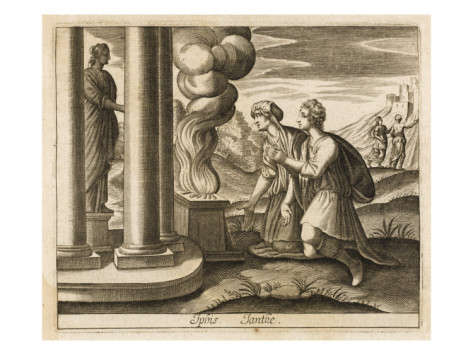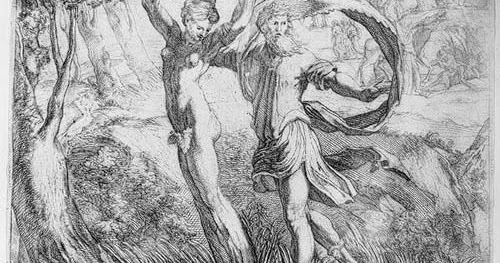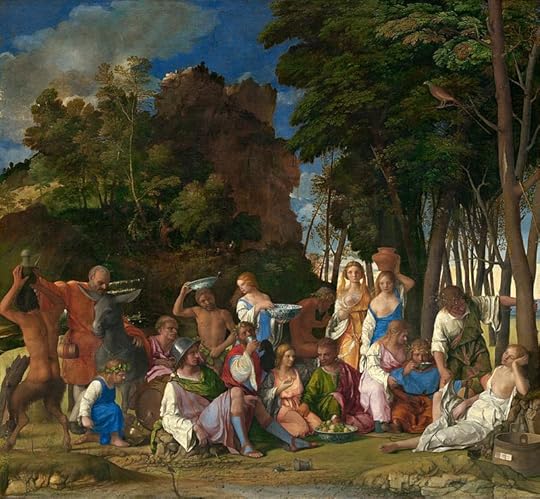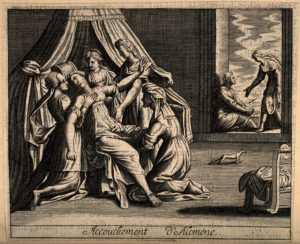 Kalliope’s
Comments
(group member since Aug 28, 2018)
Kalliope’s
Comments
(group member since Aug 28, 2018)
Kalliope’s
comments
from the Ovid's Metamorphoses and Further Metamorphoses group.
Showing 61-80 of 610
 Jim wrote: "Connecting the dots here:
Jim wrote: "Connecting the dots here:The story behind the saffron cloak worn by Hymnaeus hearkens back to an earlier event. The name 'crocus' (a variety of which is the source of saffron) is attributed to a s..."
Thank you... this makes me think I'd better be careful next time I eat paella.
:)
 The way this Book begins is very striking... Hymanaeus moving from wedding to wedding.
The way this Book begins is very striking... Hymanaeus moving from wedding to wedding. I noticed the mention of 'saffron cloak'. I knew (don't remember where I learnt this) that an orange veil or cape was used in Roman weddings.
I remember that one BBC series on Rome paid attention to this detail - the orange veil in a wedding.
 The Orpheus story is dear to me - not just because he is the son of my GR Avatar - Kalliope, but because of the Music, that Jim has already commented on.
The Orpheus story is dear to me - not just because he is the son of my GR Avatar - Kalliope, but because of the Music, that Jim has already commented on. The Gluck is one of my favourite operas.
I have this DVD:
https://www.amazon.es/Eurydice-Christ...
And there is also the beautiful version by Pina Bausch. Available in DVD (I have it) but I found it in YT.
https://www.youtube.com/watch?v=pcaZw...
And although there are paintings on this episode, as Peter has so adroitly posted them, of course it is Music the major spin off of this story.
 Peter wrote: ""A picture tells more than a thousand words." We know that this is not correct in the case of the Metamorphoses. Still it is one of the highlights of our group to combine the text with its interpre..."
Peter wrote: ""A picture tells more than a thousand words." We know that this is not correct in the case of the Metamorphoses. Still it is one of the highlights of our group to combine the text with its interpre..."Thank you for these images, Peter.
I was recently in the Naples Archaeological museum... and had seen the marble slab in reproductions, but I was unfamiliar with the Poynter. I find it striking for the moment he has chosen to depict - just before Orpheus fatally turns back to check that Eurydice proceeds without trouble.
My edition compares Ovid's with Virgil's narration of the story (the latter in the Georgics) and says that what V tells, O omits and viceversa. As for this specific moment V accounts it through a sort of crazy reaction in the part of Orpheus, while O explains it by stressing the difficulties of the journey out of Hades so that Orpheus's involuntary looking back makes sense as he just wants to make sure that the young Eurydice is ok.
 Elena wrote: "Wonderful to have you back! Your comments are always insightful..."
Elena wrote: "Wonderful to have you back! Your comments are always insightful..."Thank you, but most of my contributions is centred on images and on the notes included in my edition.
 Oh, my.
Oh, my.I am about to read this Book and just glanced through your comments. This is a major Book then and all your comments are very inviting.
I shall come back to this soon.
 Again, there are no major paintings on this Iphis episode, just engravings, several of which do not seem very clear to me... except for this one which shows the moment Telethusa visits the goddess.
Again, there are no major paintings on this Iphis episode, just engravings, several of which do not seem very clear to me... except for this one which shows the moment Telethusa visits the goddess.
 There is a 17thC French play, by Isaac de Benserade called Iphis et Ianté.
There is a 17thC French play, by Isaac de Benserade called Iphis et Ianté.I have not found information in English... here there is something on a modern French production.
https://www.theatre-contemporain.net/...
 Roman Clodia wrote: "Iphis is such an interesting story, no? Ali Smith in her Girl Meets Boy: The Myth of Iphis turns it into a joyous story but Ovid's original is more fraught, I feel.
Roman Clodia wrote: "Iphis is such an interesting story, no? Ali Smith in her Girl Meets Boy: The Myth of Iphis turns it into a joyous story but Ovid's original is more fraught, I feel. Note the tongue..."
I have just read the Iphis and final story in this Book.
I will post a few comments from the Notes in my edition.
There seems to be a point in common in the story with what was the New Comedy - which anticipates the good ending.
As both Elena and RC say, the cult of the Egyptian Isis was common in Rome. It seems that women in particular were considered under her protection.
This episode offers parallel and contrasts to the Byblis story. The latter is punished while the former is rewarded - possibly because one resists and the other gives in.
 Roman Clodia wrote: "Welcome to Book 9. For readers who have been looking for more unity in the books, the concentration on Hercules and his extended family here may make this part feel more pulled together.
Roman Clodia wrote: "Welcome to Book 9. For readers who have been looking for more unity in the books, the concentration on Hercules and his extended family here may make this part feel more pulled together. I especi..."
RC,
I have just downloaded Ali Smith's book. I have only read one of hers.
 Peter wrote: "Once again I am impressed by the modern way in which Ovid conveys the inner conflicts of women, here Byblis and Iphis. My translation is prose, so one could almost take these stories as works by an..."
Peter wrote: "Once again I am impressed by the modern way in which Ovid conveys the inner conflicts of women, here Byblis and Iphis. My translation is prose, so one could almost take these stories as works by an..."I agree, there seems to be more attention to the inner feelings of women.. as if they were more complex.
 In the Dryope episode the most interesting for me was again the emphasis on speech. She loses her mouth when she begins to speak. Her metamorphosis erases one of the main ingredients of her identity.
In the Dryope episode the most interesting for me was again the emphasis on speech. She loses her mouth when she begins to speak. Her metamorphosis erases one of the main ingredients of her identity.
 The other story is that of Dryope and Lotis narrated by Iole... again matryoshka-like stories...
The other story is that of Dryope and Lotis narrated by Iole... again matryoshka-like stories...This one is somewhat more developed than the previous one. Of course Daphne comes back to mind.
An engraving with Lotis and Pryapus - the latter a bit less obscene than usual...

And now I realise that in Bellini's famous painting of The Feast of the Gods, one of the figures is Lotis.

Giovanni Bellini. The Feast of the Gods. 1515-1529. National Gallery of Art, Washington.
Lotis. Although there are no clear attributes to help recognising her.

 On the interspersed episodes, with Galanthis and Lotis, my notes draw attention that one thing linking them together is that of 'parents and children'. Peculiar that Iole marries Hercules's son Hyllus.
On the interspersed episodes, with Galanthis and Lotis, my notes draw attention that one thing linking them together is that of 'parents and children'. Peculiar that Iole marries Hercules's son Hyllus. Anyway, Galanthis is turned into a weasel...
I have not found major images produced for this incident, just engravings. Here is one of them with the weasel.

In the text a paragraph finishes with Alcmena saying Because she came to my rescue by telling a lie when I was giving birth, she gives birth through her mouth, and as before, she has the run of my house.
The footnote explains that Greeks and Romans thought weasels gave birth through the mouth. And so Galanthis is punished for a triple mistake: lying, allowing an unwelcome birth to take place and making fun of a godhead.
 Elena wrote: "Byblis looks here a bit like a female Narcissus in 1884 painting by William-Adolphe Bouguereau from the Wikipedia piece on her.
Elena wrote: "Byblis looks here a bit like a female Narcissus in 1884 painting by William-Adolphe Bouguereau from the Wikipedia piece on her."so Byblis, Apollo's grandchild, melted away in her weeping and chang..."
I have just finished reading the Byblis episode. This is where I had stopped. But before posting on Byblis I wanted to comment on the short stories that are interspersed between Hercules and her.
 Historygirl wrote: "The image of the goddess with her legs crossed and arms locked to prevent the birth is comic and fearful. Never heard of that one, Ovid at his best..."
Historygirl wrote: "The image of the goddess with her legs crossed and arms locked to prevent the birth is comic and fearful. Never heard of that one, Ovid at his best..."Yes, this is a peculiar story, and as always in Ovid, peculiarly inserted in.. to hear of the birth of the Hero after he has become divine... one of the greatest metamorphosis so far...
 Peter wrote: "Kalliope wrote: "Peter, I have just returned from Naples, and there, in the Archaeological Museum they have the Farnese Hercules on which your German version seems to be based."
Peter wrote: "Kalliope wrote: "Peter, I have just returned from Naples, and there, in the Archaeological Museum they have the Farnese Hercules on which your German version seems to be based."Your memory is ama..."
Don't praise my memory. I saw the original recently but I had known about it and forgotten it when I saw yours....
 Peter wrote: "Kalliope wrote: "Hello everyone and my most sincere apologies. I dropped out because things in my life just got out of hand - they metamorphosed in a hydra with too many heads. I was sorry to have ..."
Peter wrote: "Kalliope wrote: "Hello everyone and my most sincere apologies. I dropped out because things in my life just got out of hand - they metamorphosed in a hydra with too many heads. I was sorry to have ..."Thank you, Peter. I am glad to be back in the group and to have return to Ovid.
 Scarlet wrote: "I am dazzled at the images you all uploaded. It is fabulous It is fantastic!"
Scarlet wrote: "I am dazzled at the images you all uploaded. It is fabulous It is fantastic!"Thank you, Scarlet... but I have fallen behind. I hope to catch up with the tragic of art works.
 I think there are no comments on the minor episode of Lichas.
I think there are no comments on the minor episode of Lichas.I feel sorry for him, since he is just a messenger who is blamed for something of which he is not responsible - bringing the poisoned tunic to Hercules.
Another case of someone 'turned to stone'. We've had several already.
Amazing painting:

Pavel Sorokin, 1849.
Then there is Canova's piece... great movement and tension.

Canova. Galleria Nazionale d'Arte Moderna, Rome. 1795.

